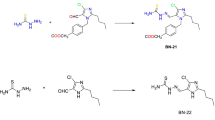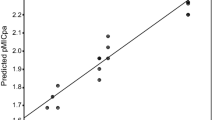Abstract
In the present work a family of novel secnidazole-derived Schiff base compounds and their copper(II) complexes were synthesized. The antimicrobial activities of the compounds were evaluated against clinically important anaerobic bacterial strains. The compounds exhibited in vitro antibacterial activity against Bacteroides fragilis, Bacteroides thetaiotaomicron, Bacteroides vulgatus, Bacteroides ovatus, Parabacteroides distasonis and Fusubacterium nucleatum pathogenic anaerobic bacteria. Upon coordination to copper(II) the antibacterial activity significantly increased in several cases. Some derivatives were even more active than the antimicrobial drugs secnidazole and metronidazole. Therefore, the compounds under study are suitable for in vivo evaluation and the microorganisms should be classified as susceptible to them. Electrochemical studies on the reduction of the nitro group revealed that the compounds show comparable reduction potentials, which are in the same range of the bio-reducible drugs secnidazole and benznidazole. The nitro group reduction potential is more favorable for the copper(II) complexes than for the starting ligands. Hence, the antimicrobial activities of the compounds under study might in part be related to intracellular bio-reduction activation. Considering the increasing resistance rates of anaerobic bacteria against a wide range of antimicrobial drugs, the present work constitutes an important contribution to the development of new antibacterial drug candidates.





Similar content being viewed by others
References
Abdelrahman MA, Salama I, Gomaa MS, Elaasser MM, Abdel-Aziz MM, Soliman DH (2017) Design, synthesis and 2D QSAR study of novel pyridine and quinolone hydrazone derivatives as potential antimicrobial and antitubercular agents. Eur J Med Chem 138:698–714
Akhi MT, Ghotaslou R, Beheshtirouy S, Asgharzadeh M, Pirzadeh T, Asghari B, Alizadeh N, Ostadgavahi AT, Somesaraei VS, Memar MY (2015) Antibiotic susceptibility pattern of aerobic and anaerobic bacteria isolated from surgical site infection of hospitalized patients. Jundishapur J Microbiol 8:e20309
Allen FH, Kennard O, Watson DG, Brammer L, Orpen AG, Taylor R (1987) Tables of bond lengths determined by X-ray and neutron diffraction. Part 1. Bond lengths in organic compounds. J Chem Soc Perkin Trans 2:S1–S19
Anderson RJ, Groundwater PW, Todd A, Worsley AJ (2012) Nitroimidazole antibacterial agents. Antibacterial agents: chemistry, mode of action, mechanisms of resistance and clinical applications. Wiley, Chichester, pp 85–101
Ang CW, Jarrad AM, Cooper MA, Blaskovich MAT (2017) Nitroimidazoles—molecular fireworks that combat a broad spectrum of infectious diseases. J Med Chem 60:7636–7657
Bollo S, Núñez-Vergara LJ, Bontá M, Chauviere G, Périé J, Squella JA (2001) Cyclic voltammetric studies on nitro radical anion formation from megazol and some related nitroimidazole derivatives. J Electroanal Chem 511:46–54
Brett CMA, Brett AMO (1993) Electrochemistry—principles, methods and applications, 1st edn. Oxford University Press Inc., New York
Breuning M, Häuser T, Mehler C, Däschlein C, Strohmann C, Oechsner A, Braunschweig H (2009) Enantioselective synthesis of tricyclic amino acid derivatives based on a rigid 4-azatricyclo[5.2.1.02,6]decane skeleton. Beilstein J Org Chem 5:81
Brook I (2016) Spectrum and treatment of anaerobic infections. J Infect Chemother 22:1–13
Carbajo J, Bollo S, Núñez-Vergara LJ, Campero A, Squella JA (2002) Cyclic voltammetric study of the disproportionation reaction of the nitro radical anion from 4-nitroimidazole in protic media. J Electroanal Chem 53:187–194
Cavalcanti JCM, Abreu FC, Oliveira NV, Moura MABF, Chaves JG, Alves RJ, Bertinaria M, Fruttero R, Goulart MOF (2004) Effect of the leaving group on the electrodic reduction mechanism of anti-Helicobacter pylori metronidazole derivatives, in aprotic and protic media. Bioelectrochemistry 63:353–357
Clinical and Laboratory Standards Institute (CLSI) (2015) Performance standards for antimicrobial susceptibility testing; twenty-fifth informational supplement. CLSI document M100-S25, Pennsylvania, USA
Corey EJ, Schmidt G (1979) Useful procedures for the oxidation of alcohols involving pyridinium dichromate in aprotic media. Tetrahedron Lett 5:399–402
De Backer E, Dubreuil L, Brauman M, Acar J, Vaneechoutte M (2010) In vitro activity of secnidazole against Atopobium vaginae, an anaerobic pathogen involved in bacterial vaginosis. Clin Microbiol Infect 16:470–472
Divar M, Khalafi-Nezhad A, Zomorodian K, Sabet R, Faghih Z, Jamali M, Pournaghz H, Khabnadideh S (2017) Synthesis of some novel semicarbazone and thiosemicarbazone derivatives of isatin as possible biologically active agents. J Pharm Res Int 17:1–13
Dunn LA, Burgess AG, Krauer KG, Erkmann L, Vanelle P, Crozet MD, Gillin FD, Upcroft P, Upcroft JA (2010) A new-generation 5-nitroimidazole can induce highly metronidazole-resistant Giardia lamblia in vitro. Int J Antimicrob Agents 36:37–42
Ehrlich J, Bartz QR, Smith RM, Joslyn DA, Burkholder PR (1947) Chloromycetin, a new antibiotic from a soil actinomycete. Science 106:417
Ferreira IP, Piló EDL, Recio-Despaigne AA, Da Silva JG, Ramos JP, Marques LB, Prazeres PHDM, Takahashi JA, Souza-Fagundes EM, Rocha W, Beraldo H (2016) Bismuth(III) complexes with 2-acetylpyridine- and 2-benzoylpyridine-derived hydrazones: antimicrobial and cytotoxic activities and effects on the clonogenic survival of human solid tumor cells. Bioorg Med Chem 24:2988–2998
Gillis JC, Wiseman LR (1996) Secnidazole. Drugs 51:621–638
Hastey CJ, Boyd H, Schuetz AN, Anderson K, Citron DM, Dzink-Fox J, Hackel M, Hecht DW, Jacobus NV, Jenkins SG, Karlsson M, Knapp CC, Koeth LM, Wexler H, Roe-Carpenter DE (2016) Changes in the antibiotic susceptibility of anaerobic bacteria from 2007-2009 to 2010-2012 based on the CLSI methodology. Anaerobe 42:27–30
Kapoor VK, Chadha R, Venisetty PK, Prasanth S (2003) Medicinal significance of nitroimidazoles—some recent advance. J Sci Ind Res 62:659–665
Kizaka-Kondoh S, Konse-Nagasawa H (2009) Significance of nitroimidazole compounds and hypoxia-inducible factor-1 for imaging tumor hypoxia. Cancer Sci 100:1366–1373
Leitsch D, Kolarich D, Wilson IBH, Altmann F, Duchêne M (2007) Nitroimidazole action in Entamoeba histolytica: a central role for thioredoxin reductase. PLoS Biol 5:1820–1834
Li Y, Zhao CP, Ma HP, Zhao MY, Xue YR, Wang XM, Zhu HL (2013) Design, synthesis and antimicrobial activities evaluation of Schiff base derived from secnidazole derivatives as potential FabH inhibitors. Bioorg Med Chem 21:3120–3126
Liu CY, Huang YT, Liao CH, Yen LC, Lin HY, Hsueh PR (2008) Increasing trends in antimicrobial resistance among clinically important anaerobes and bacteroides fragilis isolates causing nosocomial infections: emerging resistance to carbapenems. Antimicrob Agents Chemother 52:3161–3168
Löfmark S, Edlund C, Nord CE (2010) Metronidazole is still the drug of choice for treatment of anaerobic infections. Clin Infect Dis 50:S16–S23
Mendes IC, Teixeira LR, Lima R, Beraldo H, Speziali NL, West DX (2001) Structural and spectral studies of thiosemicarbazones derived from 3- and 4-formylpyridine and 3- and 4-acetylpyridine. J Mol Struct 559:355–360
Mendes IC, Moreira JP, Mangrich AS, Balena SP, Rodrigues BL, Beraldo H (2007) Coordination to copper(II) strongly enhances the in vitro antimicrobial activity of pyridine-derived N(4)-tolyl thiosemicarbazones. Polyhedron 26:3263–3270
Miyamoto Y, Kalisiak J, Korthals K, Lauwaet T, Cheung DY, Lozano R, Cobo ER, Upcroft P, Upcroft JA, Berg DE, Gillin FD, Fokin VV, Sharpless KB, Eckmann L (2013) Expanded therapeutic potential in activity space of next-generation 5-nitroimidazole antimicrobials with broad structural diversity. Proc Nat Acad Sci 110:17564–17569
Nagata N, Marriott D, Harkness J, Ellis JT, Stark D (2012) Current treatment options for Dientamoeba fragilis infections. Int. J Parasitol Drugs Drug Resist 2:204–215
O’Shea IP, Shahed M, Aguilera-Venegas B, Wilkinson SR (2016) Evaluating 5-nitrothiazoles as trypanocidal agents. Antimicrob Agents Chemother 60:1137–1140
Oxford Diffraction (2010) CrysAlisPro CCD and CrysAlisPro RED: Version 1.171.35.21 (Release 20-01-2012 CrysAlis171.NET), Oxford Diffraction Ltd, Yarnton, Oxfordshire, England
Patterson S, Wyllie S (2014) Nitro drugs for the treatment of trypanosomatid diseases: past, present, and future prospects. Trends Parasitol 30:289–298
Popiolek L (2017) Hydrazide–hydrazones as potential antimicrobial agents: overview of the literature since 2010. Med Chem Res 26:287–301
Recio-Despaigne AA, Vieira LF, Mendes IC, da Costa FB, Speziali NL, Beraldo H (2010) Organotin(IV) complexes with 2-acetylpyridine benzoyl hydrazones: antimicrobial activity. J Braz Chem Soc 21(7):1247–1257
Recio-Despaigne AA, da Costa FB, Piro OE, Castellano EE, Louro SRW, Beraldo H (2012) Complexation of 2-acetylpyridine- and 2-benzoylpyridine-derived hydrazones to copper(II) as an effective strategy for antimicrobial activity improvement. Polyhedron 38:285–290
Rodrigues C, Batista AA, Ellena J, Castellano EE, Benítez D, Hugo Cerecetto, González M, Teixeira LR, Beraldo H (2010) Coordination of nitro-thiosemicarbazones to ruthenium(II) as a strategy for anti-trypanosomal activity improvement. Eur J Med Chem 45:2847–2853
Sheldrick GM (2013) SHELXS-2013/1: program for crystal structure solution. University of Göttingen, Göttingen
Sheldrick GM (2014) SHELXL-2014/7: program for the solution of crystal structures. University of Göttingen, Göttingen
Sheldrick GM (2015) Crystal structure refinement with SHELXL. Acta Cryst C71:3–8
Spek AL (2009) Structure validation in chemical crystallography. Acta Crystallogr Sect D D65:148–155
Tan TY, Ng LS, Kwang LL, Rao S, Eng LC (2017) Clinical characteristics and antimicrobial susceptibilities of anaerobic bacteremia in an acute care hospital. Anaerobe 43:69–74
WHO Model Lists of Essential Medicines (2018) http://www.who.int/medicines/publications/essentialmedicines/en/. Accessed 28 Jan 2018
Wright PM, Seiple IB, Myers AG (2014) The evolving role of chemical synthesis in antibacterial drug discovery. Angew Chem Int Ed Engl 53:8840–8869
Zhang X, Sangani CB, Jia LX, Gong PX, Wang F, Wang JF, Zhu HL (2014) Synthesis and antibacterial evaluation of novel Schiff’s base derivatives of nitroimidazole nuclei as potent E. coli FabH inhibitors. RSC Adv 4:54217–54225
Acknowledgements
The authors gratefully acknowledge CNPq, CAPES-PNPD, FAPEMIG and INCT-INOFAR (Proc. CNPq 573.364/2008-6) for financial support and student grants. Funding was provided by CNPq (Grant Numbers 421902/2016-7 and 303746/2013-0).
Author information
Authors and Affiliations
Corresponding author
Electronic supplementary material
Below is the link to the electronic supplementary material.
10534_2018_106_MOESM1_ESM.docx
Supplementary material 1 (DOCX 1644 kb) Supplementary Information (SI) reports X-ray crystallography data of HL6, as well as the FT-IR, NMR and HRMS spectra of 2 and HL3–HL8 and FT-IR spectra of complexes (Ca–Cf). SI also contains the cyclic voltammograms of 2, HL3–HL8 and Ca–Cf. CCDC reference number 1575237 contains the supplementary crystallographic data for HL6. These data can be obtained free of charge from the Cambridge Crystallographic Data Centre via www.ccdc.cam.ac.uk/data_request/cif
Rights and permissions
About this article
Cite this article
Oliveira, A.A., Oliveira, A.P.A., Franco, L.L. et al. 5-Nitroimidazole-derived Schiff bases and their copper(II) complexes exhibit potent antimicrobial activity against pathogenic anaerobic bacteria. Biometals 31, 571–584 (2018). https://doi.org/10.1007/s10534-018-0106-6
Received:
Accepted:
Published:
Issue Date:
DOI: https://doi.org/10.1007/s10534-018-0106-6




